|
PEDAL HEIGHTS
The major change in service brakes for 1964 is in the area of the pedal and bracket for factory installed power brakes. Here pedal height is reduced, reducing stroke from 4.63 inches to 3.53 inches on Imperial and to 3.23 inches on Plymouth, Dodge, 880, and Chrysler Models.
Power brakes on Valiant and Dart are a dealer installed option, and their design is a carryover from 1963, with the 4.63-inch pedal stroke. The same holds true for dealer installed power brakes on other models.
Manual brake pedals and brackets remain the same as in 1963 models.
|
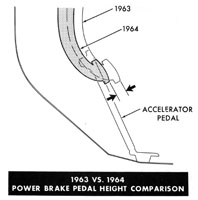
|
|
WHEEL BRAKE ASSEMBLIES
Apart from flared drums and brake adjusters, the overall design of wheel brakes remains unchanged.
As in 1963, flared drums are standard on Imperial and on Police Models of the Chrysler and "880" lines. In 1964 the flare is not as high as in 1963.
|
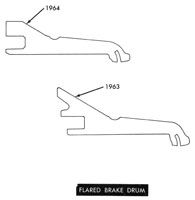
|
|
There are four different types of brake adjusters for 1964:- The automatic adjusters for nine, ten, and eleven-inch brakes, and a manual adjuster for eleven-inch brakes. The adjuster assemblies may be identified by the number of "V" and "U" grooves on the body of the pivot nut, and by the letter "R" or "L" stamped on the star wheel - "R" for the right side of the car and "L" for the left.
The automatic adjuster star wheel for ten-inch brakes has 30 teeth, while those for nine-inch and eleven-inch brakes have 24 teeth. Manual adjuster star wheels have 12 teeth.
|

|
|
POWER BRAKE BOOSTERS
Imperial retains the Bendix Dual-Diaphragm Booster, modified internally to match the low-ratio pedal.
The Valiant and Dart power brake, which is dealer installed, is a carry-over from 1963.
Plymouth, Dodge, Dodge 880, and Chrysler Factory Installed Power Brakes have a redesigned Midland Ross single diaphragm booster.
The new Midland Ross booster has a stamped front cover rather than the cast aluminum front cover used previously. The booster has a light bronze dichromate finish, similar to the finish on carburetors and alternators.
It uses a clamp band to secure the front and rear covers, similar to some other Midland-Ross boosters used in the past and currently used on the remote power brake booster in 300-K Models. If a unit is disassembled, scribe a line on the band and both shells to permit proper alignment on reassembly.
|
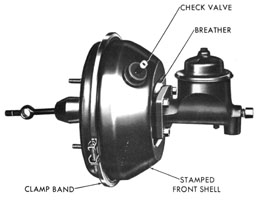
|
|
The vacuum check valve seats in a rubber grommet in an opening in the front cover of the booster. It is removed by simply pulling it out, and a new one is installed by simply pushing it in until it bottoms in the grommet.
Should a check valve need to be replaced, a new grommet should also be installed. A thin film of sil-glyde should be applied to the O.D. and the I.D. of the grommet, to facilitate installation and to aid in sealing.
Numerous changes have been made in the internal parts, some to compensate for the change in pedal ratio and some to facilitate production. These changes do not significantly affect servicing procedures, apart from non-interchangeability of parts.
Two versions of the new booster are released for 1964 Models, - One for Plymouth and Dodge and one for Dodge 880 and Chrysler Models. Care should be exercised not to interchange these units. Installing the Chrysler unit in a Plymouth would result in harsh braking. Putting a Plymouth unit in a Chrysler would provide inadequate power assist. The unit for Plymouth and Dodge may be identified by a daub of Black paint on the top of the booster.
|
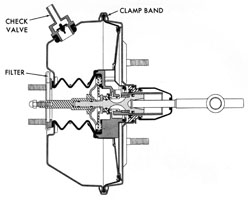
|
|
PARKING BRAKES
Parking brake systems remain essentially the same as in 1962 Models, with the exception of a change in the Imperial and Luxury New Yorker pedal and bracket assembly, which does not significantly affect servicing.
In these models, the front cable enters the passenger compartment through the toe board and attaches to a bell crank on the pedal bracket.
|
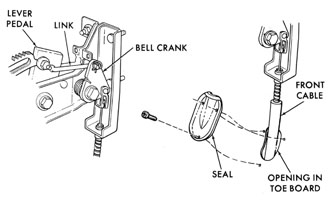
|

